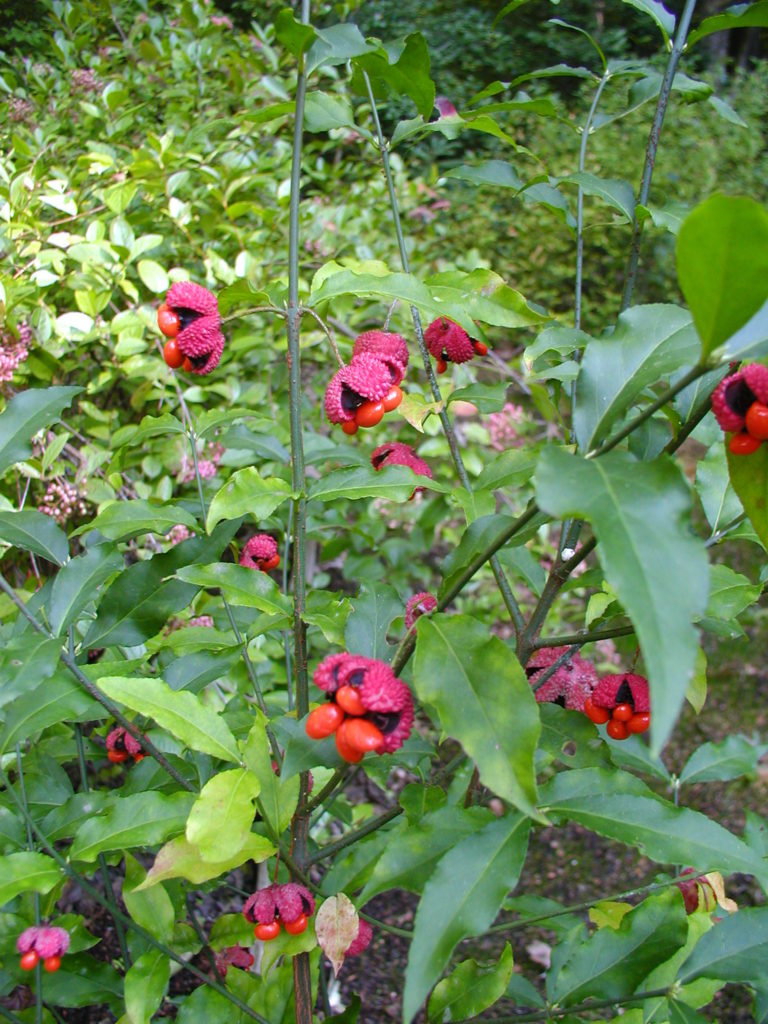Strawberrybush, or Hearts-a-Bustin’, is a unique, rhizomatous shrub with an unusual form that occurs in shady woodlands throughout the Southeast to Eastern Texas. Plants are 4-6 feet tall and multi-stemmed. The individual shoots are pencil-like and green with little branching. Leaves are long (~2 inches), opposite, and lance-shaped, colorful in fall. Most of the season it blends in with plants in woodlands or wood edges, with somewhat inconspicuous 5-parted flowers occurring in late spring. Then in the fall it makes a statement with it’s bright orange-to-scarlet berries dangling from warty, pink capsules. It is not a long-lived plant, but spreads easily by rhizomes providing the gardener with ready replacements. Although the berries are not edible by people (a very strong laxative), they support songbirds, wild turkeys and small mammals. Deer do adore to eat the stems and leaves of this plant, so much so that the presence of Strawberrybush is an indicator of low deer pressure.
NURSERY HOURS
Wednesday: 10-4 Thursday: 10-6 Friday-Saturday: 10-4 Sunday: 12-4
Euonymus americanus

Key Info
Scientific Name: Euonymus americanus L.
Common Names: Strawberry-Bush, Hearts-a-Bustin', Brook euonymus, Bursting heart, Wahoo
Family Names: Celastraceae (Bittersweet Family)
Plant Type: Tree / Shrub
Leaf Retention: Deciduous
Flower Color: White
Special Characteristics: Tolerates shade, Tolerates drought, Good fall color, Showy fruit, Tolerates wet conditions, Rhizomatous, Tolerates Black Walnut
Additional Info
Habit: Colonial shrub of straight, upright, green, wiry stems with little branching forming a loose, airy structure.
Height: 4'-6' or rarely taller
Spread: 2'-3'
Soil Conditions: Moist, average or dry, acid to alkaline, sandy, loam, clay
Leaves: Opposite, simple, narrow dark green leaves 1.5-3.5 in. long with pointed tips and finely toothed margins; shades of red fall.
Flowers (or reproductive structures: Creamy white to pink, five-parted, 1/3-inch, perfect flowers on inch-long peduncles at axils of the opposite leaves.
Fruit: Green, spiny seed pods ~ 1 inch acrossd turn bright red/pink prior to 'bursting', exposing 3-5 pendulous, bright orange seeds (arils) in the fall; very showy.
Natural Distribution: Deciduous woods, sandy thickets, swamplands, woodlands, ravines, stream sides.
USDA Hardiness Zone: 6 to 10
USDA Wetland Indicator Status in NC: FAC
Pollination: Bees, beetles, flies, ants
Wildlife Connections: Attracts deer, seeds are eaten by song birds and wild turkeys.
Propagation: By seed or by division.
